In 2015, Mauviel dropped a rivet from its handles, and as a collector, I think this is a problem for the brand.
At the start of its current era of manufacturing (which I date to 2008), Mauviel offered three types of handle: cast iron; brass (often mistranslated by Mauviel as “bronze”); and polished stainless steel. The iron and brass handle designs have been consistent for 150 years; the “Mauviel 1830” design for the stainless steel handles was borrowed from the M’cook line. These handles were used across Mauviel’s copper product lines from 2008 to 2014.





But over the 2015 and 2016 model years, Mauviel remade their brass and cast iron handles. In many cases, the handles were updated to the “Mauviel 1830” design, but other handles are plainer, or with a different logo.
But in all cases, the new handles have just two rivets, and this, in my opinion, is the problem.
M’150b to 150b2
For the 2015 product year, the M’150b handle was updated to the “Mauviel 1830” design and designated the 150b2. Here’s the same sauce pot from 2014 to 2015, showing the redesign and rivet reduction. (The Mauviel website continues to refer to the new line as the 150b2, but the Mauviel catalog and most retail partners such as Williams-Sonoma and Dehillerin still call it the 150b. You have to see pictures or, better yet, ask what they have in stock to know for sure.)

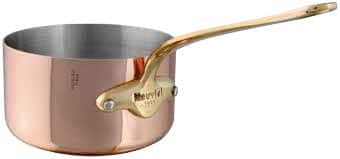
(Most of the Mauviel stock photos — also used on Mauviel’s website and partner retailers — look to have been composited with Photoshop: a photo of the pan body of the right shape has a photo of the correct version of handle pasted onto it. You can see the same pan and handle images reused from year to year and from one model line to another, and if you look closely you can also see pixel artifacts where the graphic designer adjusted the image a little — to delete a rivet, for example. I include these photos not for the fine visual detail but to show you the broad-brush elements from year to year — handle shape, rivet count, etc. — from Mauviel itself. It’s my preference to use real-world photos and I’ve included them when I know exactly what year the photo is representing.)
Below is how the M’150b2 handle redesign and rivet reduction look on a wide handgrip handle, such that you would find on a stockpot or rondeau.


M’250b to 250b2
The M’250b series received a different brass handle treatment. For the 2015 model year, the middle rivet was simply deleted, and for 2016 the open space was marked with a round “M” stamp. The new handles are designated M’250b2 on the Mauviel website starting in January 2017; other retail partners continue to refer to them as 250b, so once again, check closely or ask before you buy.



 The round M appears to be the simplified “M1830” logo that Mauviel is using on its recent pans. It was first trademarked in 2011 and has started to appear on Mauviel’s stainless lines, such as on the button handles of glass lids. The brass “M” handles are taking some time to percolate through to Mauviel’s retail partners; as of April 2019, Dehillerin shows a mix of handles on its M’250c series, with and without the M logo. Here are some closeups — I have some better photos of the M stamp further along in this post.
The round M appears to be the simplified “M1830” logo that Mauviel is using on its recent pans. It was first trademarked in 2011 and has started to appear on Mauviel’s stainless lines, such as on the button handles of glass lids. The brass “M” handles are taking some time to percolate through to Mauviel’s retail partners; as of April 2019, Dehillerin shows a mix of handles on its M’250c series, with and without the M logo. Here are some closeups — I have some better photos of the M stamp further along in this post.



M’150c/250c to 150c2/250c2
As with the brass handles, Mauviel took two years to migrate its cast iron handle design. In 2015, the handle deleted the center rivet from the baseplate, and in 2016, adopted the “Mauviel 1830” design. Mauviel’s website changed over from “c” to “c2” between May and November 2016. The c2 handle is not cast iron, but instead “iron electroplated finish” and I have an entire post coming on this (here it is).

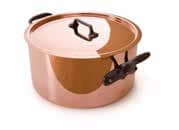

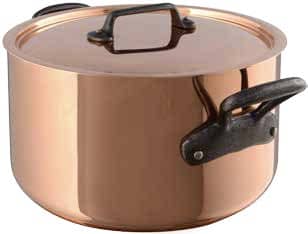


Williams-Sonoma began carrying the 250c2 starting in April 2017.
M’tradition
Prior to the 2015 model year, the M’tradition line — tin-lined, copper-riveted pieces — had the same three-rivet brass or cast iron handles they’d had for 150 years. For the 2015 and 2016 model years, the brass and cast iron handles went through the same two-year sequence of design changes as the 250b and 250 series.
Brass handles
The changes here are the same as for the M’250b line: for the 2015 model year, Mauviel deleted the middle rivet, leaving a blank space as with the 2015 M’250b2. For 2016, the blank space is filled by the round “M” stamp as with the 2016 M’250b2 above.



Dehillerin is currently (April 2019) showing a mix of two- and three-rivet handles on its tin-lined Mauviel pieces. Here are some good photos of the M-stamped brass handle and a plain handle.
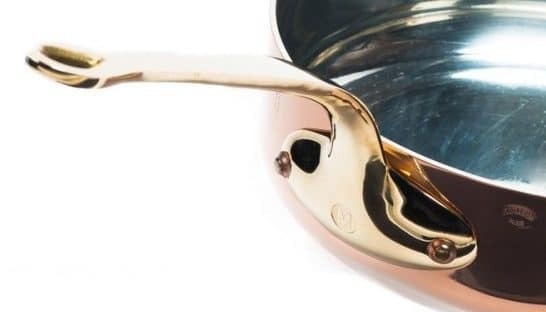


Cast iron handles
I don’t have “official” photos of M’tradition pieces with cast iron handles prior to 2016 because it’s difficult to find photos online. But logically Mauviel would use the same handles here as they did on their M’150c/250c series, following a similar change schedule. What’s missing is a photo of the “plain” cast iron handle as we saw in the M’250c for 2015, but I am keeping an eye on eBay to see if one comes up with good photos.
What I know for sure is that the 2016 catalog, iron-handled M’tradition pieces with the “iron electroplated” c2 handle identical to that on the M’250c2. (Ignore the fact that the photo of the saucepan shows steel rivets, not copper; Mauviel reused stock photos from one pan to another and didn’t bother to correct the rivet color. The skillet rivets are copper colored as they are in reality.)


I discuss the transition from the cast iron handle to the “iron electroplated” handle in more detail in a separate post.
The bottom line for me
In terms of usability, the loss of one rivet is negligible for the M’héritage line but significant for the M’tradition line. In terms of collectibility, in my opinion these two-rivet pans are less desirable than their older three-rivet versions, and you should seek out three-rivet pans before they’re gone.
Usability
The M’héritage line — copper lined with stainless steel, with handles fastened with stainless steel rivets — never really needed three rivets in the first place. When the steel-lined Cuprinox line came out in 1995, Mauviel used the same three-rivet cast iron and brass handles it had on hand for its tinned Cupretam line, and that became the look and feel of the new line — it looked just like tinned copper, but with a stainless lining. But steel rivets can withstand quite a bit of force, as hundreds of thousands of stainless steel pans with two-rivet handles can attest.

But for the M’tradition line — copper lined with tin, with handles fastened with copper rivets — the loss of a rivet is a bigger deal. Copper is much softer than steel, and copper rivets can stretch and loosen if a lot of force is applied to the handle. (Coppersmiths tighten or, if needed, replace copper rivets as a matter of course during retinning.) I have read anecdotally (and will link to it when I can find it) that Mauviel intended the bump on the lower rim of the baseplate to help manage torque between handle and pot, and while that may be true, it’s still a bit unsettling to me.
Collectability
The quotes below are all taken from publicity by and about Mauviel.
According to Valérie Mauviel Gilbert, a sixth generation descendant of Ernest [Mauviel], “The strength and foundation for Mauviel’s manufacturing expertise is based upon this rich tradition of copper manufacturing that has been handed down from generation to generation. This year [2010] we celebrate the heritage that has inspired the designs of today.”
The M’héritage collection represents the total experience and heritage of Mauviel 1830.
Manufactured following over a century of experience and “savoir-faire”, the M’tradition line embodies the tradition of professionalism of the Mauviel cookware lines. The timeless product, manufactured using the very best raw material, continues to gain value over the years.
I am genuinely surprised that Mauviel, a brand that trumpets tradition and heritage as core values, should move away from one of its most iconic design elements: the handles it has used for more than 150 years and photographed lovingly and lavishly to convey the quintessence of the brand. I think these changes were cost-cutting measures, and while I ultimately have no right to criticize Mauviel for how it navigated its business choices, I think this change reduces the quality and collectibility of these pieces.
I can’t argue with the pragmatism of re-structuring all product lines to a two-rivet handle format. Visualize it: prior to 2015, M’150s pots needed to be drilled for two holes for their stainless handles, while M’150b, 150c, 250b, 250c, and M’tradition needed three holes for their brass or iron handles. Transforming all pots to a two-rivet configuration means that every copper pot body can be drilled the same and specific handles attached as needed. Reducing rivets also means 33% fewer rivets per pot, 33% fewer steps to drill holes, and 33% fewer opportunities to spoil a pot with errors. I suspect this can make a difference over thousands of pots and I can’t fault Mauviel for seeking these efficiencies.
But from a marketing and branding perspective, this transition has been mis-handled (no pun intended). First, Mauviel never mentioned the rivet reduction. This is obviously a loss for the pot, so what is the benefit to the customer? Mauviel has been silent about this, which leads me to conclude that there is no benefit for the customer.
Second, the changes were handled at different speeds: the M’150b went to the 150b2 in one model year, but the M’250b lines took two years to get to their updated versions. Why change one line and not the others? I am sure there must have been some logistical reason for this, but it is clumsy. (There are reasons for delayed rollout in the cast iron handled lines, as I cover separately.)
And the new handle designs are not even settled at this moment. Some b2 handles have the “Mauviel 1830” branding, but others have the “M” cartouche stamp; there are different versions of handle shown on pans in the M’250c2 lineup at Williams-Sonoma. This leads me to suspect that the point of the b-to-b2 and c-to-c2 migration was not to strengthen and consolidate the visual branding around “Mauviel 1830,” but instead to get from three rivets to two as quickly as possible without regard to the appearance of the final handle.
Ultimately, I don’t know what’s going on at Mauviel, but as far as I can tell nobody else does either. My fear is that they are withdrawing their support from the tin-lined M’tradition line overall and focusing on copper bimetal, copper multi-ply, copper clad, and other hybrid designs. I want Mauviel to survive and prosper but I cannot help but feel dismay at the changes they’ve made, particularly those to the old-style copper-riveted pans.
My advice to you, as I said up front: Buy up the three-riveted Mauviel pieces if you can find them, and if you have three-riveted pans from the 2000s to 2015, cherish them. In my opinion, they’ll always be worth more than the two-riveted production after 2015.
Corrections
In the course of researching another post, I’ve come to the conclusion that Mauviel did not actually produce a 2016 catalog. The closest I can come is a “Mauviel 2016-2017 Highlights” catalog that would have been published in late 2016 or early 2017 (and that’s a guess). I’ve corrected the photo captions accordingly.



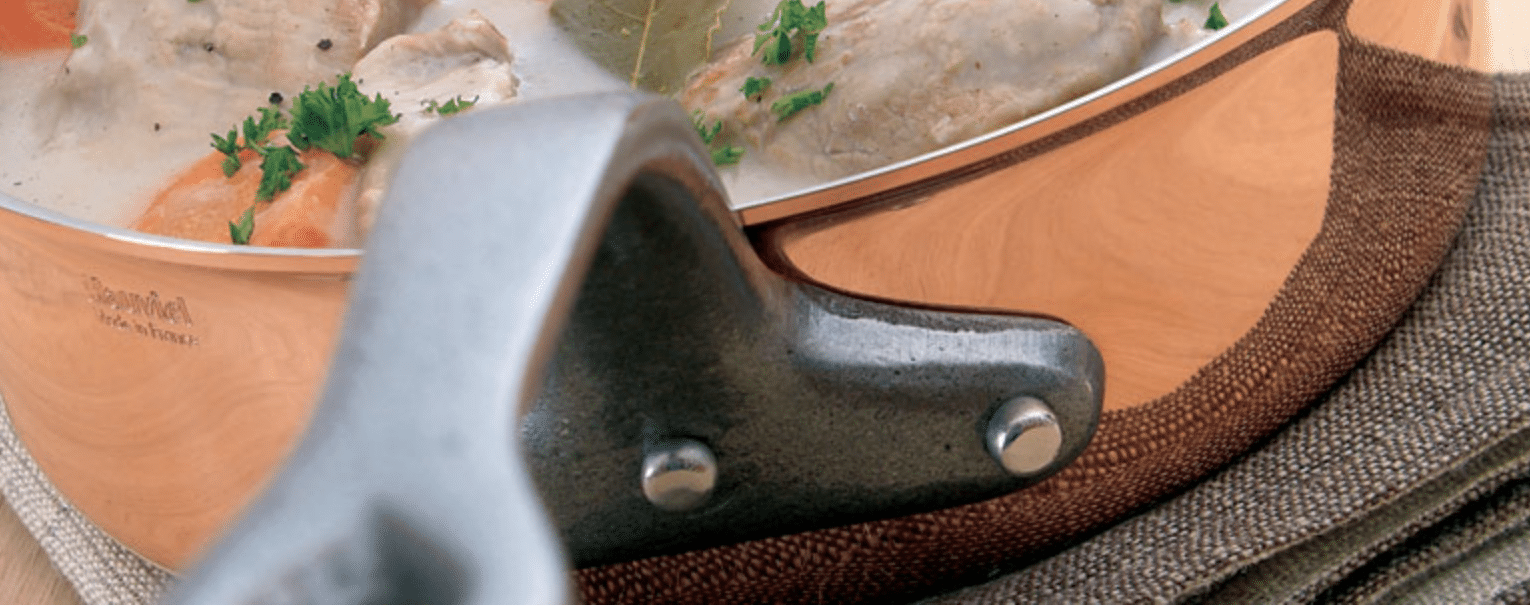
What a fascinating and extensively-researched examination of the Mauviel company’s use of, and then abandonment of, three-rivet handles over the years. The shift from three to two rivets in the handles in the M’traditional line of tin-lined copper was particularly ironic (it’s called “tradition,” right?) Leaving aside the question of tradition and appearance, I wonder what the science says. Have there been engineering studies? Are two-rivet handles in M’tradition tin-lined copper pots definitely weaker and more prone to breaking? If so, it is definitely a step backward for the company.
Thanks for the compliments — I’m glad you found it thought-provoking. I don’t know that there have been actual engineering studies of Mauviel’s pieces, but there are certainly materials science studies of copper versus steel. Steel is brittle, while copper is both malleable and ductile — it will bend, not break. Copper rivets under strain will stretch, not snap, while steel rivets will take a lot more force and then shear off. I don’t think snapping steel rivets is a realistic possibility in home use, but I do think that reducing the number of copper rivets requires each one to carry more strain, which logically increases the risk of deformation.
This is interesting and fascinating– thank you. I have a question about the rivets themselves– are the steel rivets used ONLY on the steel lined items, or do you also see steel rivets on some tin lined items? I think they use steel rivets only with steel lining in current production, but has that always been the case?
Hey Ali! To the best of my knowledge, Mauviel has always used copper rivets with tinned pans and steel rivets with steel-lined or nickeled pans. Other makers can vary: I’ve seen low-quality aluminum rivets on tinned pieces, and I’ve also seen copper rivets dabbed with tin on the outside to make them look silvery. But AFAIK, Mauviel has always used copper with tin and steel with steel or nickel.